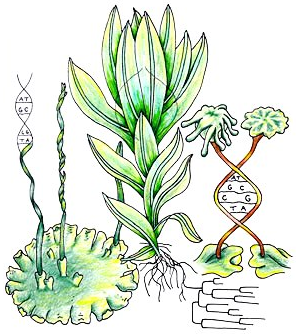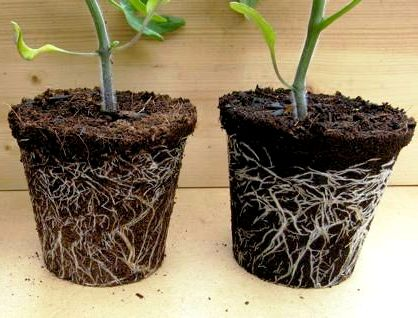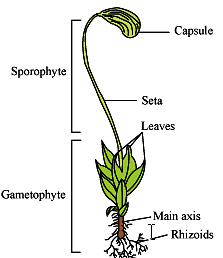Bryophytes
Table of Content |

 - Bryophytes- (Gk.bryon- moss, phyton- plant)
- Bryophytes- (Gk.bryon- moss, phyton- plant)
- Bryophytes are nonvascular terrestrial plants of moist habitats in which a multicellular diploid sporophyte lives as a parasite on an independent multicellular haploid gametophyte that develops multicellular jacketed sex organs.
- The plants are small. they seldom attain great length or height, the maximum being 60cm for a moss species growing in New Zealand.
- Roots absent. Instead rhizoids occur. The latter may be unicellular or multicellular.
- Accessory spores are not formed.
- Sex organs are multicellular and jacketed.
- An external layer of water is essential for the swimming of male gametes to the archegonia.
Differences Between Antheridia and Archegonia
|
S.No. |
Antheridia |
Archegonia |
|
1. |
They are male organs of bryophytes and pteridophytes. |
They are female organs of bryophytes,pteridophytes and gymnosperms. |
|
2. |
Antheridia are generally rounded in outline. |
Archegonia are usually flask-shaped in outline. |
|
3. |
Sterile cells are absent inside. |
|
|
4. |
An antheridium forms a large number of male gametes. |
An archegonium encloses a single female gamete. |
|
5. |
The male gametes produced in an antheridium are usually motile. |
The female gamete or egg present in an archegonium is usually non-motile. |
Characteristics of Bryophytes
-
Bryophytes include the various mosses and liverworts that are found commonly growing in moist shaded areas in the hills.
-
Bryophytes are also called amphibians of the plant kingdom because these plants can live in soil but are dependent on water for
 sexual reproduction. They usually occur in damp, humid and shaded localities.
sexual reproduction. They usually occur in damp, humid and shaded localities. -
They play an important role in plant succession on bare rocks/ soil.
-
The plant body of bryophytes is more differentiated than that of algae. It is thallus-like and prostrate or erect, and attached to the substratum by unicellular or multicellular rhizoids. They lack true roots, stem or leaves. They may possess root-like, leaf-like or stem-like structures.
-
The main plant body of the bryophyte is haploid. It produces gametes, hence is called a gametophyte. The sex organs in bryophytes are multicellular. The male sex organ is called antheridium. They produce biflagellate antherozoids. The female sex organ called archegonium is flask-shaped and produces a single egg. The antherozoids are released into water where they come in contact with archegonium. An antherozoid fuses with the egg to produce the zygote. Zygotes do not undergo reduction division immediately. They produce a multicellular body called a sporophyte.
-
The sporophyte is not free-living but attached to the photosynthetic gametophyte and derives nourishment from it. Some cells of the sporophyte undergo reduction division (meiosis) to produce haploid spores. These spores germinate to produce gametophyte.
Economic Importance of Bryophytes
-
Bryophytes in general are of little economic importance but some mosses provide food for herbaceous mammals, birds and other animals.

-
Species of Sphagnum, a moss, provide peat that have long been used as fuel, and because of their capacity to hold water as packing material for transshipment of living material.
-
Mosses along with lichens are the first organisms to colonize rocks and hence, are of great ecological importance. They decompose rocks making the substrate suitable for the growth of higher plants.
-
Since mosses form dense mats on the soil, they reduce the impact of falling rain and prevent soil erosion.
Life Cycle of Bryophytes
-
The life cycle of bryophytes consists of two distinct phases - the gametophytic phase and the sporophytic phase.
-
The haploid gametophyte is dominant, long lived, green and independent whereas the diploid sporophyte is short lived and dependent upon the gametophyte.
-
The two phases are morphologically distinct.
-
The gametophytes are either thalloid (i.e., not differentiated into true roots, true stem and true leaves) or leafy shoot having stem-like central axis and leaf-like appendages.
-
The vascular tissue (i.e., xylem and phloem) are completely absent.
-
The bryophytes are fundamentally terrestrial plants but require presence of water to complete their life cycle.
-
The water is needed for dehiscence of antheridia, liberation of antherozoids, transfer of antherozoids from anthertdta to archegonia, opening of archegonial neck, and the movement of antherozoids into the archegonial neck.
Classification of Bryophytes
-
Campbell (1940), Smith (1955), Takhtajan (1953) divided bryophyte, into three classes namely Hepaticae, Anthocerotae and Musci.
-
Proskauer (1957) changed the names of these classes in accordance with the recommendations of the code, into Hepaticopsida; Anthocerotopsida and Bryopsida.
-
The Latin word Hepatica means liver. Thus the members of hepticopsida are popularly known as liverworts.
-
The members of bryopsida are commonly known as mosses.
Liverworts
-
The liverworts grow usually in moist, shady habitats such as banks of streams, marshy ground, damp soil, bark of trees and deep in the woods.

-
The plant body of a liverwort is thalloid, e.g., Marchantia. The thallus is dorsiventral and closely appressed to the substrate. The leafy members have tiny leaf-like appendages in two rows on the stem-like structures.
-
Asexual reproduction in liverworts takes place by fragmentation of thalli, or by the formation of specialised structures called gemmae (sing. gemma).
-
Gemmae are green, multicellular, asexual buds, which develop in small receptacles called gemma cups located on the thalli. The gemmae become detached from the parent body and germinate to form new individuals.
-
During sexual reproduction, male and female sex organs are produced either on the same or on different thalli. The sporophyte is differentiated into a foot, seta and capsule. After meiosis, spores are produced within the capsule. These spores germinate to form free-living gametophytes.
Mosses
-
The predominant stage of the life cycle of a moss is the gametophyte which consists of two stages.

-
The first stage is the protonema stage, which develops directly from a spore. It is a creeping, green, branched and frequently filamentous stage.
-
The second stage is the leafy stage, which develops from the secondary protonema as a lateral bud.
-
They consist of upright, slender axis bearing spirally arranged leaves. They are attached to the soil through multicellular and branched rhizoids. This stage bears the sex organs.
-
Vegetative reproduction in mosses is by fragmentation and budding in the secondary protonema.
-
In sexual reproduction, the sex organs antheridia and archegonia are produced at the apex of the leafy shoots.
-
After fertilisation, the zygote develops into a sporophyte, consisting of a foot, seta and capsule.
-
The sporophyte in mosses is more elaborate than that in liverworts.
-
The capsule contains spores. Spores are formed after meiosis. The mosses have an elaborate mechanism of spore dispersal.
-
Common examples of mosses are Funaria, Polytrichum and Sphagnum.
Funaria
-
Funaria is known as common moss or green moss or cord moss.
-
The main plant body of Funaria is gametophyte and is of two forms.
(1) Juvenile form (creeping protonema)
(2) Adult form (leafy gametophore)
-
Protonema is the branched filamentous portion which is produced by germination of spores. It is ephemeral or short lived.

-
Leafy gametophore develop from buds produced on protonema and is made up of axis with spirally arranged leaves. It is 1-3 cm in height, green and is monopodially branched.
-
The main branch of leafy gametophore bears male reproductive organs, e.g., antheridia and the side branch is female branch.
-
Funaria reproduces both by vegetative and sexual methods.
(1) Vegetative reproduction: Vegetative reproduction takes place by fragmentation, primary protonema, secondary protonema, bulbils, gemma and apospory.
(2) Sexual reproduction: The Funaria plants are monoecious and autoecious, i.e., male (antheridia, club shaped) and female (archegonia, flask shaped) reproductive organs are produced on, the same plant but on different branches. Male organs mature first and hence Funaria plants are Protandrous,
-
There are two generations in life cycle of Funaria, i.e., gametophytic generation (n) which is independent and complex and sporophytic generation (2n) which is partially dependent upon gametophytic generation.
-
These two generations follow each other in regular sequence. This is called heteromorphic or heterologous alternation of generations.
Riccia
-
The main plant body of Riccia is gametophytic (n). It is small, green, flat and fleshy.
-
The thallus is dorsiventral and dichotomously branched.
-
The thalli are present in the form of patches called rosettes.
-
Scales are found on the margins, while rhizoids are present in the mid-rib region of thallus.
-
Rhizoids are unicellular and unbranched and are of two types - smooth and tuberculate.

-
Rhizoids help in fixation. In submerged species, (e.g., R. fluitans) scales and rhizoids are not present.
-
Riccia reproduces by both vegetative and sexual method.
(1) Vegetative reproduction: Riccia reproduces vegetatively by progressive death and decay, persistent apices (R. discolor), adventitious branches (R. fluitans), tubers (R. billardieri, R. discolor, R. perennis) and by rhizoid (R. glauca).
(2) Sexual reproduction: Sexual reproduction is oogamous type in Riccia. Antheridia and archegonia 'are the male and female sex organs respectively.
-
Most of the species are monoecious or homothallic, i.e., male and female sex organs are present on the same thallus.
-
A few species are dioecious or heterothallic, i.e., antheridia and archegonia are present on different thalli.
-
Common dioecious species of Riccia are R.himalayensis and R. frostii.
-
There are 2 generations in life cycle of Riccia.
(i) The main plant body is garnetophytic (n). The gametophytic phase starts with formation of spores and ends with fertilization. The second phase is sporophytic phase (2n), which starts with zygote and ends with reduction division of spore mother cell.
(ii) The sporophytic phase is dependent upon gametophyte. Thus there is heteromorphic or heterologous alternation of generations in Riccia. So life 'Cycle in Riccia is diplohaplontic.
Question1: First land inhabiting plants are
(a) Angiosperms
(b) Gymnosperms
(c) Bryophytes
(d) Pteridophytes
Question2: Which one of the following is not a cryptogam
(a) Algae
(b) Bryophyta
(c) Pteridophyta
(d) Gymnosperms
Question3: Triploid condition is only present in
(a) Bryophytes
(b) Pteridophytes
(c) Gymnosperms
(d) Angiosperms
Question4: Which one of the following is not a member of thallophyta
(a) Spirogyra
(b) Mucor
(c) Moss
(d) Both (b) and (c)
Question5: Archegoniatae include
(a) Algae, fungi and viruses
(b) Algae, lichens and bryophytes
(c) Bryophytes, pteridophytes and gymnosperms
(d) Pteridophytes, gymnosperms and angiosperms
Question6: In which of the following groups would you place a plant which produces seeds but lacks flower and fruits
(a) Fungi
(b) Bryophytes
(c) Pteridophytes


| Q.1 | Q.2 | Q.3 | Q.4 | Q.5 | Q.6 |
| c | d | d | c | c | d |
Related Resources
-
Click here to refer the Useful Books of Biology for NEET (AIPMT)
-
Click here for study material on Animal Kingdom
To read more, Buy study materials of Plant Kingdom comprising study notes, revision notes, video lectures, previous year solved questions etc. Also browse for more study materials on Biology here.
View courses by askIITians


Design classes One-on-One in your own way with Top IITians/Medical Professionals
Click Here Know More

Complete Self Study Package designed by Industry Leading Experts
Click Here Know More

Live 1-1 coding classes to unleash the Creator in your Child
Click Here Know More

a Complete All-in-One Study package Fully Loaded inside a Tablet!
Click Here Know MoreAsk a Doubt
Get your questions answered by the expert for free





